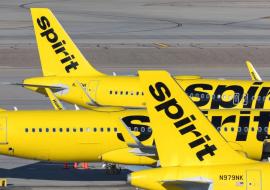IATA Reports Dip in Air Traffic for November
The International Air Transport Association (IATA) said international scheduled traffic results for November showing 8.2 percent year-on-year passenger traffic growth and a 5.4 percent increase for freight. Passenger load factor for November averaged 75.6 percent while the freight load factor stood at 55.2 percent for the month. But traffic growth in November slowed from the 10 percent increase recorded in the passenger business and the 14.5 percent growth in freight in October.
IATA said the slowdown in 2010 is partially skewed because of the exceptionally rapid rise in traffic volumes recorded during the fourth quarter of 2009. However, when viewed in absolute terms, air travel fell by 0.8 percent and air freight fell by 1.1 percent between October and November 2010. According to IATA, this slower growth does not necessarily signal a negative trend. Even with the decline in November, passenger and freight traffic are still expanding at annualized rates of between 5 percent and 6 percent, which is in line with the industry’s historical growth trend.
“The industry is shifting gears in the recovery cycle,” said Giovanni Bisignani, IATA’s director general and CEO. “Growth is slowing towards normal historical levels in the 5-6 percent range. Relative weakness in developed markets is being offset by the momentum of economic expansion in developing markets. We see a strong end to 2010 that boosted the year’s profit forecast to $15.1 billion. Slowing traffic growth is in line with our projections for a reduced profit of $9.1 billion in 2011. That’s a 1.5 percent margin. More hard work will be needed in the New Year to achieve sustainable levels of profitability.”
The level of international air travel is now 4 percent above the pre-recession peak of early 2008. All regions, except Africa, reported a slowing in year-on-year growth rates from October to November. European airlines recorded 7.3 percent growth in passenger traffic, below the 9.4 percent recorded in October. Overall travel performed by the region’s carriers is only slightly ahead of the pre-recession levels of early 2008. In absolute terms there was a 1.7 percent fall in traffic volumes for the region’s carriers between October and November. Industrial labor action and adverse weather conditions particularly affected Europe’s carriers at the very end of the month. The impact of these will continue to be seen in December’s traffic, according to IATA.
North American carriers saw their growth slow from 12.4 percent in October to 9.5 percent in November. Capacity growth in November was 9.5 percent, resulting in a load factor of 78.1 percent, the highest among the regions. November passenger traffic levels for North American carriers equaled the pre-recession levels of early 2008.
Asia-Pacific carriers saw their growth slow from 7.3 percent in October to 5.8 percent in November. Capacity expanded relatively in tandem (5.9 percent) for a load factor of 75.6 percent. Despite the region’s strong economic growth and financial performance, November traffic levels were still 2 percent below pre-recession levels.
Latin American carriers showed the most dramatic decline in growth rates—from 4.9 percent in October to virtually zero in November. The lingering impact of the failure of Mexicana is the largest contributing factor in this decline, which resulted in a 2.1 percent absolute contraction of travel performed by the region’s carriers between October and November. Adjusting figures to eliminate the impact of Mexicana, the region would be experiencing growth in the low double digits. The region’s load factor stands at 77.5 percent.
Middle East carriers saw their growth rate decline from 17.8 percent in October to 16.7 percent in November. The region’s carriers handled 16 percent more traffic in November than at the pre-recession peak in early 2008, showing that they have gained market share over the course of the recession and the recovery. The region recorded a load factor of 74.3 percent, below the global average of 75.6 percent. African carriers were the only region to show an increase in growth rates from October (12.6 percent) to November (16.4 percent). The region’s carriers moved 11 percent more travelers in November than they did at the pre-recession peak in early 2008.














